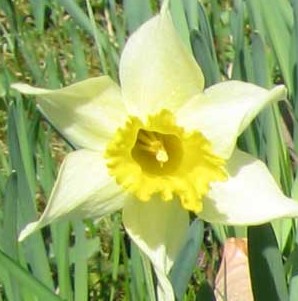 Narcissus is a genus in the amaryllis family (Amaryllidaceae) and also includes plants known as daffodils and jonquils. The narcissus that Shakespeare is referring to is probably Narciss pseudonarissus also called the wild daffodil. It is native to England as well as to western Europe from Spain and Portugal to Germany where it grows in woods, grasslands and rocky areas. The flowers are pale yellow with a darker yellow trumpet and produced singly on a leafless stem. The leaves are gray-green and grass-like and arise from the bulb.
Narcissus is a genus in the amaryllis family (Amaryllidaceae) and also includes plants known as daffodils and jonquils. The narcissus that Shakespeare is referring to is probably Narciss pseudonarissus also called the wild daffodil. It is native to England as well as to western Europe from Spain and Portugal to Germany where it grows in woods, grasslands and rocky areas. The flowers are pale yellow with a darker yellow trumpet and produced singly on a leafless stem. The leaves are gray-green and grass-like and arise from the bulb.
In Two Noble Kinsmen (act ii, sc. 2, 130) Emilia and her maid servant talk together;
This garden has a world of pleasures in’t
What flow’r is this?
Maid Servant
‘Tis called narcissus, madam.
Emilia
That was a faire boy certaine, but a fool,
To love himself; where there not maides enough?
Emilia’s response to her maid servant refers to the Greek myth of Narcissus, a youth who was changed into a flower by the gods after falling in love with his own image in a stream. Some believe the flower was named after this youth but other experts believe that the name comes from the Greek word narc referring to a narcotic believed to be present in the scent of the narcissus. In Shakespeare’s time, the botanist John Gerard mentions narcissus as well as daffodils.